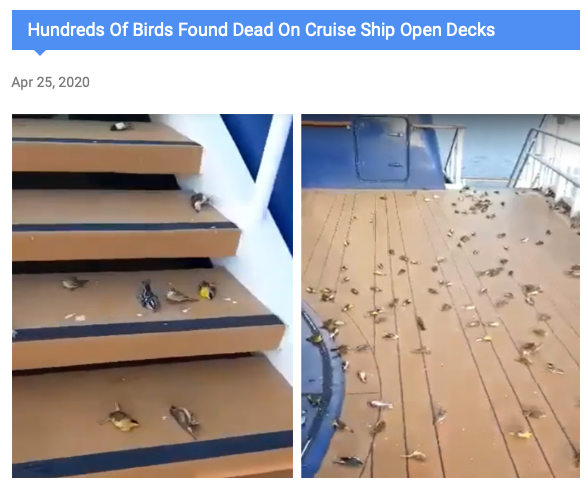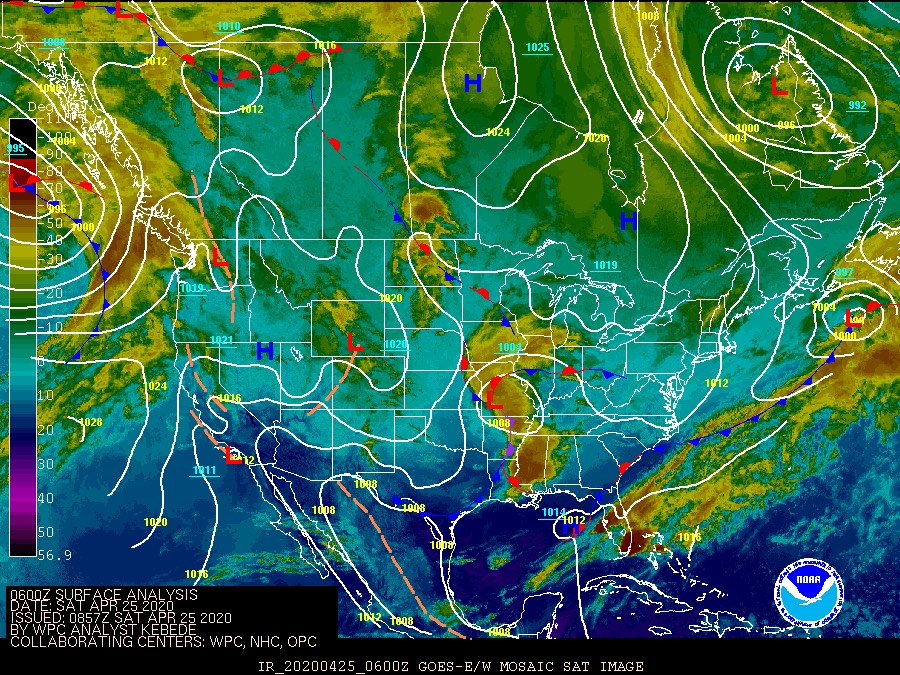
BirdCast reports on many aspects of bird migration, and sadly one scenario we encounter is mass mortality during migration. For example sometimes birds are downed when migrating over water, only to be found in the stomachs of tiger sharks; other times birds collide with myriad structures. In this case, we were alerted to a post, highlighted below, in which many dead birds and clearly a few live birds (at least) were reported from the decks of a ship on or around 24-25 April 2020. We do not have details on which ship, or where exactly this occured. This video suggests that a major mortality event occurred, and, from the limited scope of what we can learn from the video, that the event involved hundreds of birds (or more). In the video, numerous species are apparent, including Common Yellowthroat, Ovenbird, Northern Waterthrush, Black-throated Blue Warbler, Black-and-white Warbler, Yellow-throated Warbler, American Redstart, and more.
We do not know the circumstances of this event, and we would like to gather additional information. If you have any additional details on exactly where this occurred and the circumstances under which it occurred, we would like to hear from you.
Hundreds of birds found dead on cruise ship open decks pic.twitter.com/bQFVkP0TL5
— Crew Center (@CrewCenter) April 25, 2020
BirdCast would like to offer some interpretation of events based on our research and the best available science we have at our disposal. Attraction to and disorientation by light is an all too common and increasing occurrence during nocturnal migration (see recent research here, here, here, and here). So, a simple explanation with supporting science is that these nocturnally migrating birds were attracted to and then disoriented by the lights of this cruise ship (this happens, for example, here), resulting in collisions and mortality. A bit more of an explanation is necessary for how and why the birds were present in the first place. Again, we have supporting science that can help us inform the discussion.
First, species composition of the birds in the video is consistent with migrant songbirds wintering in the Caribbean (for example, Black-throated Blue Warbler). These birds are on the move, appearing in the eastern US and Canada in increasing numbers with each passing day. This composition and the timing of the mortality event suggest that the ship was probably east of Florida and north of the eastern Greater Antilles. There is also the possibility, based on the account of clear weather, that the ship was farther south east of Cuba.
Second, weather conditions during the 23-25 April 2020 window were dynamic and at times intense. The image below shows a frontal boundary associated with the passage of low pressure (the red L) east of Nova Scotia as well as precipitation distributed offshore (see the red, orange, and yellow colors from peninsular Florida north and east to the low pressure center). This front moved slowly off the coast over the 36 hours preceding this image, creating similar conditions during that period. With southerly winds (from the south) ahead of the advancing front, birds moving downwind would travel offshore; when encountering weather, birds would fly at low altitudes and attempt to find any available location to land, including ships, oil rigs, or the nearest land mass.

Third, several accounts from birders (i.e. citizen scientists) reporting bird observations to eBird suggest, as BirdCast discussed with a previous weather system, the transport of birds offshore by this and other recent strong storms; the observations include several checklists from Bermuda (23 April 1, 2 and 27 April) and additional reports of migrants appearing in Newfoundland (e.g. Blue Grosbeak).
Bottom line: we suspect that this ship was positioned off the southeastern US or in the Bahamas, or in close proximity to these areas, during the 23-24 April 2020 window when events leading to an entrainment and subsequent displacement of migrating birds offshore brought them into the intense illumination of the idle ship during the night. A plausible alternative hypothesis could represent a scenario in which birds were moving as normal from areas south and east of the front, and simply encountered the brightly illuminated ship during typical clear night conditions, attracted to and then disoriented by the lights with devastating consequences.
Given the large number of cruise ships currently idle, and usually operational, in this region, the potential for additional events of this sort may be significant. If you have additional information, please reach out to the BirdCast team.




